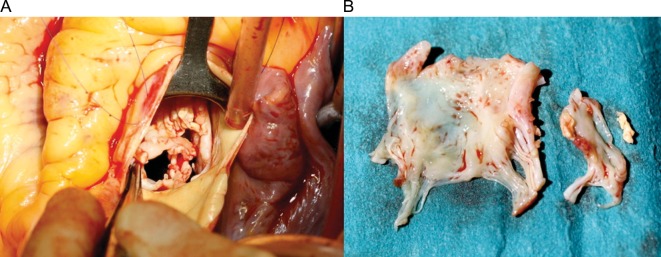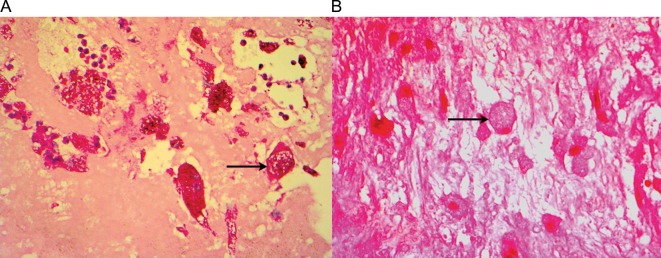Abstract
Whipple's disease, caused by the bacterium Tropheryma whipplei, is a rare chronic multi-system illness commonly affecting the gastrointestinal (GI) tract and presenting with a triad of diarrhoea, weight loss and malabsorption. While 20–55% of patients with a diagnosis of Whipple's disease have clinically evident cardiac manifestations, the initial presentation with isolated valvular disease, without any GI symptoms, is rare. Whereas cardiac involvement usually involves a single valve, cases of double-valve involvement are extremely rare. We report the case of a patient with T. whipplei native aortic and mitral valvular endocarditis, without GI involvement, who presented with the new-onset cardiac failure and ventricular arrhythmias, which required urgent double-valve replacement. This case report is accompanied by a review of the relevant literature.
Keywords: Culture-negative endocarditis, Whipple's disease, Tropheryma whipplei
INTRODUCTION
Whipple's disease, first described in 1907 by Whipple and subsequently demonstrated to be caused by the bacterium Tropheryma whipplei, is a rare (<1 per 106 population) chronic multi-system illness commonly affecting the gastrointestinal (GI) tract and presenting with a triad of diarrhoea, weight loss and malabsorption [1, 2]. While 20–55% of patients with a diagnosis of Whipple's disease have clinically evident cardiac manifestations, the initial presentation with isolated valvular disease is rare. Whereas cardiac involvement usually involves a single valve, cases of double-valve involvement are extremely rare. We report the case of a patient with T. whipplei native aortic and mitral valvular endocarditis without GI involvement and review the relevant literature.
CASE PRESENTATION
A 50-year old Caucasian male presented with a 2-week history of progressive exertional dyspnoea and chest pain. A 1-year history of intermittent polyarthritis and joint swelling had led to a recent diagnosis of pseudogout.
On examination, he was tachycardic and hypoxic (SaO2 92%) with a pansystolic murmur and bi-basal crepitations. A chest radiograph showed cardiomegaly and pulmonary oedema and electrocardiography confirmed atrial fibrillation with a rate of 150 bpm. Blood tests revealed haemoglobin 11.9 g/dl, white blood cell 10.5 × 109/L, C-reactive protein 111 mg/L and a rise in Troponin I from 1.87 to 3.10 ng/mL at 12 h. His condition rapidly deteriorated. Following two episodes of ventricular fibrillation and subsequent ST elevation in his echocardiography, he was transferred urgently to the regional cardiothoracic centre. Coronary angiography revealed normal coronary arteries and a dilated left ventricle with an ejection fraction of 25%. A transthoracic echocardiogram demonstrated torrential aortic regurgitation, moderate mitral regurgitation, pulmonary hypertension (pulmonary artery pressure of 60 mmHg) and vegetations on the aortic and mitral valves.
He underwent urgent mechanical aortic and mitral valve replacement. The native aortic valve was bicuspid with vegetations on both leaflets and the detachment of the non-coronary leaflet (Fig. 1), and the mitral valve had multiple smaller vegetations on both leaflets (Fig. 1). All infected tissue was completely excised and both valves replaced with mechanical prostheses, supra-annular for the aortic and intra-annular for the mitral. The posterior mitral annulus was resuspended with two 4/0 Gore-Tex® neochords to maintain the left ventricular geometry.
Figure 1:
The intraoperative images of the in situ aortic valve following aortotomy (A) and excised mitral valve (B).
A presumptive diagnosis of culture-negative endocarditis was made on the basis of six negative blood cultures. Subsequent valvular histology demonstrated foamy macrophages and granular cytoplasm that with periodic acid Schiff (PAS) staining revealed particulate material, characteristic of Whipple's disease (Fig. 2). A polymerase chain reaction (PCR) assay targeting the 16S RNA sequence of T. whipplei was positive. The patient was converted from broad-spectrum antibiotics to intravenous ceftriaxone for 14 days followed by oral co-trimoxazole for at least 1 year. He remains under review and at the 9-month follow-up was asymptomatic with normally functioning aortic and mitral prostheses and good left ventricle function.
Figure 2:
Foamy macrophages (arrowed) stained with (A) Periodic acid-Schiff diastase and (B) hematoxylin and eosin.
DISCUSSION
Our PubMed search strategy included ‘Whipple’, ‘Tropheryma’ and ‘endocarditis’ up to May 2011 and identified 67 articles of which 23 reports described a total of 33 cases of T. whipplei endocarditis without GI involvement [3–8]. The bibliographies of retrieved articles were searched for the relevant articles and the ‘related articles’ function was used for a further check of rigour. Double reporting was identified and these reports were excluded from our review. A review published in 2010, which included the literature published up to 2008, identified at least 97 cases of Whipple's endocarditis irrespective of GI involvement [8]. Our review identified 10 new patients, taking the total to 107 cases of which almost one-third did not have GI involvement.
Focusing on the 33 cases of Whipple's endocarditis without GI involvement, the majority were men (82%) in their late 50s and 60s (median age of 58, range 41–80 years) with native valve endocarditis (94%) on structurally normal valves (bicuspid aortic valve, n = 3; rheumatic, n = 1). The most common acute symptoms were attributable to a heart failure (61%) or embolic events (24%) often associated with a prolonged period (8 months–20 years) of arthralgia (48%) and weight loss. Fever was present in 10 (30%) cases. The isolated involvement of the aortic (52%), mitral (18%) and tricuspid (3%) valves occurred in a decreasing order of frequency, whereas double-valve involvement occurred in 9 of the 33 cases (aortic + mitral, n = 8; aortic + tricuspid, n = 1).
Valve replacement surgery was performed in 31 patients and all resected valves were positive for T. whipplei by PCR testing. Two cases were successfully managed conservatively with antibiotic therapy alone, the diagnosis being confirmed via the PCR in blood or pleural fluid, or lymph node biopsy. Antibiotic regimens were highly variable, including treatment with doxycycline, hydrochloroquinine, gentamicin, amoxicillin and vancomycin. Only one randomized controlled trial regarding the treatment of Whipple's disease has been published; it recommends the use of meropenem or ceftriaxone for 14 days followed by oral co-triamoxole for 12 months [9]. The outcome was reported in 30 cases (the follow-up range 4 months–6 years), with 10% mortality (n = 3), all within the first week following surgery.
Only two patients in this review fulfilled Duke's criteria for endocarditis; it has previously been suggested that the criteria should be modified to include direct molecular identification via the PCR in the blood culture material, as an additional major criterion [10]. The aim would be to achieve an earlier diagnosis and the commencement of treatment, but this would be unlikely to change the need for surgical intervention as the majority of patients with Whipple's endocarditis present in extremis, symptomatic of irreversible valvular destruction during the prolonged prodromal period.
In summary, T. whipplei is a rare cause of culture-negative endocarditis, where the diagnosis is complicated by the non-specific nature of the presenting symptoms. Nevertheless, it should be considered when males in their 50s and 60s present with a long-history of arthralgia, new-onset heart failure and echocardiographic findings suggestive of valvular regurgitation or endocarditis.
ACKNOWLEDGEMENTS
We would like to acknowledge Ken Palmer, John Gosney, Alastair Miller, Mike Beadsworth, James Anson and Carlos Nistal de Paz for their expert assistance with this case.
Conflict of interest: none declared.
References
- 1.La Scola B, Fenollar F, Fournier PE, Altwegg M, Mallet MN, Raoult D. Description of Tropheryma whipplei gen. nov. sp. nov., the Whipple's disease bacillus. Int J Syst Evol Microbiol. 2001;51(Pt 4):1471–9. doi: 10.1099/00207713-51-4-1471. [DOI] [PubMed] [Google Scholar]
- 2.Moos V, Schneider T. Changing paradigms in Whipple's disease and infection with Tropheryma whipplei. Eur J Clin Microbiol Infect Dis. 2011;30:1151–8. doi: 10.1007/s10096-011-1209-y. [DOI] [PubMed] [Google Scholar]
- 3.Brondex A, Jobic Y. Infective endocarditis as the only manifestation of Whipple's disease: an atypical presentation. Ann Cardiol Angeiol (Paris) 2012;61:61–3. doi: 10.1016/j.ancard.2010.12.005. [DOI] [PubMed] [Google Scholar]
- 4.Gabus V, Grenak-Degoumois Z, Jeanneret S, Rakotoarimanana R, Greub G, Genné D. Tropheryma whipplei tricuspid endocarditis: a case report and review of the literature. J Med Case Rep. 2010;4:245. doi: 10.1186/1752-1947-4-245. [DOI] [PMC free article] [PubMed] [Google Scholar]
- 5.Gubler JG, Kuster M, Dutly F, Bannwart F, Krause M, Vögelin HP, et al. Whipple endocarditis without overt gastrointestinal disease: report of four cases. Ann Intern Med. 1999;131:112–6. doi: 10.7326/0003-4819-131-2-199907200-00007. [DOI] [PubMed] [Google Scholar]
- 6.Aïouaz H, Célard M, Puget M, Vandenesch F, Mercusot A, Fenollar F, et al. Whipple's disease endocarditis: report of 5 cases and review of the literature. Rev Med Interne. 2005;26:784–90. doi: 10.1016/j.revmed.2005.07.012. [DOI] [PubMed] [Google Scholar]
- 7.Raoult D, Birg ML, La Scola B, Fournier PE, Enea M, Lepidi H, et al. Cultivation of the bacillus of Whipple's disease. N Engl J Med. 2000:620–5. doi: 10.1056/NEJM200003023420903. [DOI] [PubMed] [Google Scholar]
- 8.Escher R, Roth S, Droz S, Egli K, Altwegg M, Täuber MG. Endocarditis due to Tropheryma whipplei: rapid detection, limited genetic diversity, and long-term clinical outcome in a local experience. Clin Microbiol Infect. 2010;16:1213–22. doi: 10.1111/j.1469-0691.2009.03038.x. [DOI] [PubMed] [Google Scholar]
- 9.Feurle GE, Junga NS, Marth T. Efficacy of ceftriaxone or meropenem as initial therapies in Whipple's disease. Gastroenterology. 2010;138:478–86. doi: 10.1053/j.gastro.2009.10.041. [DOI] [PubMed] [Google Scholar]
- 10.Millar B, Moore J, Mallon P, Xu J, Crowe M, Mcclurg R, et al. Molecular diagnosis of infective endocarditis—a new Duke's criterion. Scand J Infect Dis. 2001;33:673–80. doi: 10.1080/00365540110026764. [DOI] [PubMed] [Google Scholar]




